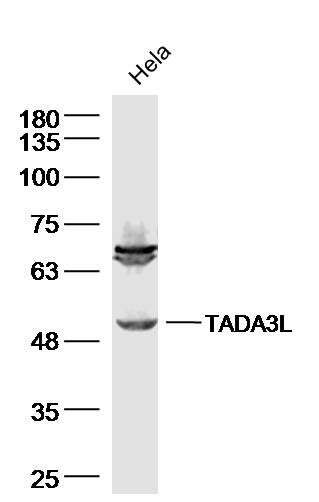TADA3L Polyclonal Antibody
Purified Rabbit Polyclonal Antibody (Pab)
- SPECIFICATION
- CITATIONS
- PROTOCOLS
- BACKGROUND

Application
| WB, IHC-P, IHC-F, IF, ICC |
|---|---|
| Primary Accession | O75528 |
| Reactivity | Rat, Pig, Dog, Bovine |
| Host | Rabbit |
| Clonality | Polyclonal |
| Calculated MW | 49 KDa |
| Physical State | Liquid |
| Immunogen | KLH conjugated synthetic peptide derived from human TADA3L |
| Epitope Specificity | 251-350/432 |
| Isotype | IgG |
| Purity | affinity purified by Protein A |
| Buffer | 0.01M TBS (pH7.4) with 1% BSA, 0.02% Proclin300 and 50% Glycerol. |
| SIMILARITY | Belongs to the NGG1 family. |
| SUBUNIT | The PCAF complex is composed of a number of TBP-associated factors (TAFS), such as TAF5, TAF5L, TAF6, TAF6L, TAF9, TAF10 and TAF12, PCAF, and also PCAF-associated factors (PAFs), such as TADA2L/ADA2, TADA3L/ADA3 and SPT3. Interacts directly with TADA2L and PCAF and also with the high-risk HPV oncoprotein E6. Component of the STAGA transcription coactivator-HAT complex, at least composed of SUPT3H, GCN5L2, TAF5L, TAF6L, SUPT7L, TADA3L, TAD1L, TAF10, TAF12, TRRAP and TAF9. Component of the TFTC-HAT complex. Component of the ADA2A-containing complex (ATAC), composed of CSRP2BP, KAT2A, TADA2L, TADA3L, ZZ3, MBIP, WDR5, YEATS2, CCDC101 and DR1. |
| Important Note | This product as supplied is intended for research use only, not for use in human, therapeutic or diagnostic applications. |
| Background Descriptions | DNA-binding transcriptional activator proteins increase the rate of transcription by interacting with the transcriptional machinery bound to the basal promoter in conjunction with adaptor proteins, possibly by acetylation and destabilization of nucleosomes. The protein encoded by this gene is a transcriptional activator adaptor and a component of the histone acetyl transferase (HAT) coactivator complex which plays a crucial role in chromatin modulation and cell cycle progression. Along with the other components of the complex, this protein links transcriptional activators bound to specific promoters, to histone acetylation and the transcriptional machinery. The protein is also involved in the stabilization and activation of the p53 tumor suppressor protein that plays a role in the cellular response to DNA damage. Alternate splicing results in multiple transcript variants of this gene. [provided by RefSeq, May 2013] |
| Gene ID | 10474 |
|---|---|
| Other Names | Transcriptional adapter 3, ADA3 homolog, hADA3, STAF54, Transcriptional adapter 3-like, ADA3-like protein, TADA3, ADA3, TADA3L |
| Target/Specificity | Ubiquitously expressed. |
| Dilution | WB=1:500-2000,IHC-P=1:100-500,IHC-F=1:100-500,ICC=1:100-500,IF=1:100-500 |
| Storage | Store at -20 ℃ for one year. Avoid repeated freeze/thaw cycles. When reconstituted in sterile pH 7.4 0.01M PBS or diluent of antibody the antibody is stable for at least two weeks at 2-4 ℃. |
| Name | TADA3 |
|---|---|
| Synonyms | ADA3, TADA3L |
| Function | Functions as a component of the PCAF complex. The PCAF complex is capable of efficiently acetylating histones in a nucleosomal context. The PCAF complex could be considered as the human version of the yeast SAGA complex. Also known as a coactivator for p53/TP53- dependent transcriptional activation. Component of the ATAC complex, a complex with histone acetyltransferase activity on histones H3 and H4. |
| Cellular Location | Nucleus |
| Tissue Location | Ubiquitously expressed. |

Thousands of laboratories across the world have published research that depended on the performance of antibodies from Abcepta to advance their research. Check out links to articles that cite our products in major peer-reviewed journals, organized by research category.
info@abcepta.com, and receive a free "I Love Antibodies" mug.
Provided below are standard protocols that you may find useful for product applications.
If you have used an Abcepta product and would like to share how it has performed, please click on the "Submit Review" button and provide the requested information. Our staff will examine and post your review and contact you if needed.
If you have any additional inquiries please email technical services at tech@abcepta.com.













 Foundational characteristics of cancer include proliferation, angiogenesis, migration, evasion of apoptosis, and cellular immortality. Find key markers for these cellular processes and antibodies to detect them.
Foundational characteristics of cancer include proliferation, angiogenesis, migration, evasion of apoptosis, and cellular immortality. Find key markers for these cellular processes and antibodies to detect them. The SUMOplot™ Analysis Program predicts and scores sumoylation sites in your protein. SUMOylation is a post-translational modification involved in various cellular processes, such as nuclear-cytosolic transport, transcriptional regulation, apoptosis, protein stability, response to stress, and progression through the cell cycle.
The SUMOplot™ Analysis Program predicts and scores sumoylation sites in your protein. SUMOylation is a post-translational modification involved in various cellular processes, such as nuclear-cytosolic transport, transcriptional regulation, apoptosis, protein stability, response to stress, and progression through the cell cycle. The Autophagy Receptor Motif Plotter predicts and scores autophagy receptor binding sites in your protein. Identifying proteins connected to this pathway is critical to understanding the role of autophagy in physiological as well as pathological processes such as development, differentiation, neurodegenerative diseases, stress, infection, and cancer.
The Autophagy Receptor Motif Plotter predicts and scores autophagy receptor binding sites in your protein. Identifying proteins connected to this pathway is critical to understanding the role of autophagy in physiological as well as pathological processes such as development, differentiation, neurodegenerative diseases, stress, infection, and cancer.


